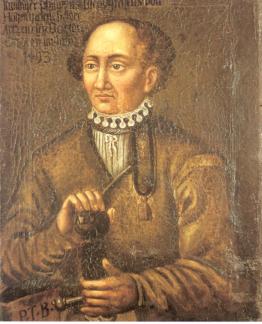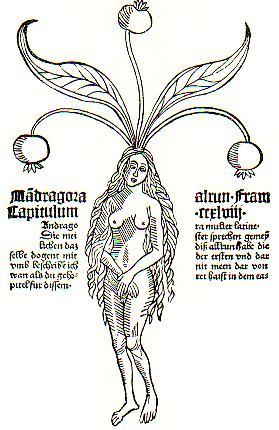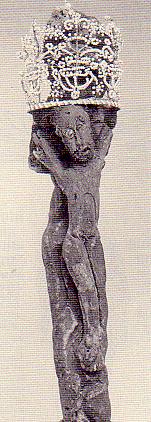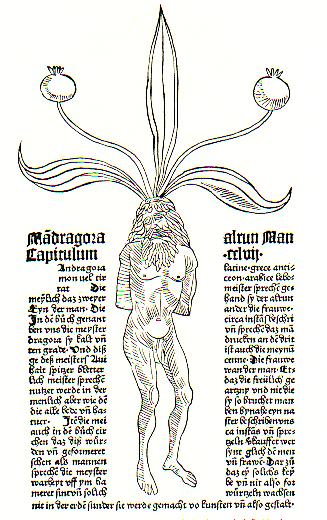Paracelsus’s ideas
were of a strong influence on the very first
Rosicrucian book ever written.
(See among others “The Magic Flute” by M.F.M. van den Berk, 2004.) Although
there were certainly those with sympathies for what they apparently believed
was a real society; it is not clear that there were any actual Rosicrucians and modern scholars agree that the whole thing
was a hoax which, caught on. In other words what's interesting is not that
there weren't any Rosicrucians, but that people cared
whether there were or weren't, and wanted there to be. And an emphasis on
Hermetic origins seems to have gained prominence in Paracelsian
literature during the second half of the sixteenth century.
The popular
Psychologist Carl G. Jung Jung describes Paracelsus
as “a pioneer of empirical psychology and psychotherapy”, and makes mention of
the post-Paracelsus emergence of a “fantastic species of literature”.

And where the above
period is termed that of the (non-existant)’ older’ Rosicrucians the later period termed that of the ‘later’ Rosicrucians had very well living people among its
creations. For example Hermann Fictuld (a
correspondent with the theosopher Friedrich Christoph
Oetinger, 1702-1782), is seen as one of the founders of what later came to
be known as the Gold- and Rosenkreutz a quasi Masonic order. In fact following the collapse due to
scandal of Baron von Hund's `Strict Observance' Knights Templar strain of
Freemasonry in 1782, the Gold- and Rosenkreutz even
became the dominant force within the German Craft, alongside the Bavarian
'Illuminati' (also largely influenced by the idea of early Rosicrucian’s).
The Gold- and Rosenkreutz was marked by its anti-Enlightenment stance and
its emphasis on Christian piety and alchemy. Alchemical ideas and symbols were
incorporated into the rituals of initiation and the teachings that accompanied each
grade; laboratory alchemy was also an important part of the work of the order
from the third degree onwards, and those members reaching the seventh grade
were deemed to have knowledge of the Philosophers' Stone.Paracelsian
and Valentinian alchemy were the order of the day, although there were some
members who denied the tria prima of Paracelsus.
In the work that has
been described as the `Bible' of the Gold- and Rosenkreutz
Order, the Compass der Weisen (1779), we find an
extensive survey of alchemical and Rosicrucian writings, compiled by a frater Roseae et Aureae Crucis with the
partial aim of making them comprehensible within the context of Freemasonry.
The author names a number of early modern writers as authorities, including
Michael Maier, Heinrich Khunrath, Robert Fludd, Thomas Vaughan, Gerhard Dorn, Basil Valentine and
Adrian von Mynsicht. The introduction deals with the
occult knowledge of the Egyptians.
Alchemy itself was
originally an offshoot of the decorative arts, whose practitioners had begun in
late antiquity to view their products in Pygmalion-like fashion as
replications, rather than representations, of the natural world. Always aware
of the potential charge that they too were engaged in a sort of trompe l'oeil
trickery, the medieval and early modern alchemists explicitly claimed that
their discipline perfected nature rather than merely imitating it. This view
built on the distinction that Aristotle draws in the Physics (11 8 199a15-17),
where he states that "the arts either, on the basis of Nature, carry
things further (epitelei) than Nature can, or they
imitate (mimeital) Nature. To alchemical writers,
this meant that most other fields leading to physical production, such as shipbulding, fabric making, and the visual arts, merely
mimicked natural products-either in a loose and general sense, as in the old
stories that based the invention of architecture on the observation of
swallows' nests and weaving on the activity of spiders, or in the specific
sense that pertained to painting, sculpture, and other representational arts.
The Mandrake,
or Alraun, -root of German folk legends was the
probable the source for an idea even the founder of Scientology attempted
to manifest (and his fellow Aleister Crowley student)
, that of creating a ‘Homunculus’ or ‘moon child’.( Paracelsus,
De natura rerum, in Sudhoff, 11:348-349. See p. 349:
"ein ding sein form und gestalt ganz und gar sol verlieren und zu nicht werden und aus nichts widerumb etwas, das hernach vil
edler in seiner kraft und rugent dan
es erstlich gewesen ist.")
The Mandrake/Alraun root was visualized to look like a little
human, and was often kept in a bottle or flask at the time, and is strikingly
reminiscent of the homunculus found in the pseudo-Paracelsian
De natura rerum. Also in medieval times there where already speculations on
incubi and succubi to produce an image of the
artificial man excelling over normal humans in intelligence, strength. The
author of the De natura rerum however inserted the alchemical paragon of human
art into this preexisting framework by now claiming that by incubating a flask
at moderate heat, one can isolate the male seed from the female and so produce
a transparent, almost bodiless homunculus. See, Joachim Telle,
"Kurfürst Ottheinrich, Hans Kilian und Paracelsus: Zum pfälzischen Paracelsismus im 16. Jahrhundert," in Von Paracelsus
zu Goethe und Wilhelm von Humboldt, Salzburger Beiträge zur Paracelsusforschung
22 (Vienna: Verband der Wissenschaftlichen Gesellschaften Osterreichs,
1981),130-146; R.J. W Evans, Rudolph II and His World (Oxford: Clarendon Press,
1973);Jost Weyer, GrafWolfgangll von Hohenlohe und
die Alchemie(Sigmaringen:J. Thorbecke,
1992); Bruce Moran, The Alchemical World of the German Court (Stuttgart:
Franz Steiner, 1991).



Or as William R.
Newman recently concluded; Paracelsus argues that the mandrake incorrectly
described by necromancers and philosophers is really a homunculus, which they
have misidentified. Paracelsus is probably thinking here of the old German folk
legend that the Alraun (alreona)
grew primarily beneath gallows, where it was generated from the sperm or urine
of hanged criminals: in honor of its provenance, the Alraun
was also called Galgenmann or Galgenmännlein
("gallows man"). This belief has been traced back to Avicenna and is
mentioned by early modern German authors such as Brunfels.
In the seventeenth century it was still believed in some quarters that such a
gallows man could also be produced by burying the sperm of a young man
underground and periodically feeding the developing embryo with more of the
same." In order to understand Paracelsus's reasoning in the above passage,
one must realize that he customarily employs the expression venter equinus, a technical term in alchemy for decaying dung used
as a heat source, to mean any source of low, incubating heat. Thus it was easy
for him to interpret the mandrake legend as a garbled recipe for the
homunculus, where the earth beneath the gallows acted as a venter equinus or incubator (Newman, Promethean Ambitions, 2004,
p. 215).
The homunculus,
moreover, was closely tied to the issue of palingenesis, the artificial rebirth
of living things by chymical means, which enjoyed a
widespread religious significance in the seventeenth century. As we noted
before, the De natura rerum of pseudo-Paracelsus refers to the
"clarification" of a bird by combustion to ash which is in turn
allowed to ferment into a "mucilaginous phlegm." The rebirth of the
clarified bird from this phlegm is evidently a naturalistic explanation of the
ancient Phoenix myth. The De natura rerum links this process explicitly to the
making of the homunculus. Directly after the recipe for the clarified bird, the
text says the following: "One must also know that people may be born thus
without natural father and mother." The homunculus recipe too involves the
use of a mucilaginous phlegm, although in its case this substance is provided
by a living human donor rather than being produced from ash. Both in the case
of the artificial bird and in that of the artificial human, the phlegm is
allowed to putrefy in an alchemical flask, which must be tended by a spagyrist
(chymist).
The theme of rebirth
appears again in the sixth book of the De natura rerum, with the extravagant
story of Virgil's failed experiment that is used to support the regeneration of
dissected snakes. The end of this book carries the process of resuscitation
into another area as well, that of the vegetable world. Pseudo-Paracelsus
claims that wood must be burnt to ash and then placed into a vessel along with
the "resin, liquor, and oiliness" (resina, liquore,
and oleitet) of the same tree. The chymist should then allow this to putrefy into a
mucilaginous material as in the case of the incinerated bird, again with a mild
heat. Within this slimy substance}the three Paracelsian
principles exist-mercury, sulfur, and salt-in the form of the watery moisture
that evaporated from the burning wood, the flammable oil that it released
during combustion, and the salt that was left after the conflagration was over.
In order to regenerate the tree from its principles, one need only pour the
putrefied material into a suitable soil, upon which the tree will grow again,
but nobler and more vigorous than before. From this phenomenon the author of
the De natura rerum generalizes to the following conclusion: "a thing
should entirely lose its form and shape, and become nothing, and become again
something out of nothing, which has afterward become much nobler in its power
and virtue than it was originally."
One of the most
famous appearances of the Homunculus however is in the neo-Paracelsian
Chymieal Wedding of Christian Rosencreutz,
a baroque Bildungsroman published in 1616, written anonymously by Johann
Valentin Andreae. The hero of the romance, Rosencreutz, receives an anonymous invitation to the
mysterious wedding of a king and queen, delivered to him by a beautiful, winged
lady. After seeing a castle with invisible servants, a mysterious play
featuring lions, unicorns, and doves, and a roomful of wondrous self-moving
images, Rosencreutz finally meets the bride and
groom. At the end of a sumptuous dinner accompanied by an elaborate comedy, the
joyful couple, along with their royal retinue, are abruptly beheaded by a
"very cole-black tall man." (John Warwick
Montgomery, Cross and Crucible: Johann Valentin Andreae
(1586-1654), Phoenix of the Theologians, vol. 2,1973,414).
Their blood being carefully
collected, the bodies are then dissolved into another red liquor by Rosencreutz and a group of fellow alchemists. These laborants summarily congeal the fluid in a hollow globe,
whereon it becomes an egg. The alchemists then incubate the egg, which hatches
a savage black bird: the bird is fed the collected blood of the beheaded,
whereupon it molts and turns white and then iridescent. After a series of
further operations, the bird, now grown too gentle for its own good, is itself
deprived of its head and burnt to ashes.( J.W. Montgomery,Cross
and Crucible, 1971, vol. 2: p.440-456.)
This panoply of
processes is an obvious recitation of the traditional regimens or color-stages
that were supposed to lead to the agent of metallic transmutation, the philosophers'
stone. Indeed, the philosophers' stone was often described as the end result of
processes figuratively pictured in terms of copulating kings and queens who are
murdered and reborn. But in the end, the bodies of this bride and groom are
reassembled out of the ashes of the unfortunate bird by placing the moistened
mass into two little molds. Upon heating, there appear "two beautiful
bright and almost Transparent little Images ... a Male and a Female, each of
them only four inches long," which are then infused with life.
These are identified
in the margin as Homunculi duo. (Cross and Crucible,vol.
2:p.458.)
The reader, having
expected the end result to be the philosophers' stone, may be somewhat
surprised at this result. This at least was the reaction of the alchemists who
were employed at the court of the decapitated couple, for Rosencreutz
informs us that they imagined the process to have been carried out "for
the sake of Gold," adding that "to work in Gold... is indeed a piece
also of this art, but not the most Principal, most necessary, and best."
In short, according to the Chymical Wedding of
Christian Rosencreutz, the real goal of alchemy is
the artificial generation of human beings, and the manufacture of precious
metals only a sideline.
Andreae, the author of The Chymical
Wedding, was a well-known Lutheran theologian and the composer of the utopian Christianopolis. Perhaps it is unnecessary to say that for Andreae, the production of homunculi is largely an allegory
of spiritual regeneration with the aim of charming the reader rather than
teaching him to be a Frankenstein. (Montgomery, Cross and Crucible, vol. 2,
where the author demonstrates this point exhaustively in his commentary to the
text).
Andreae's reorientation of alchemy to the spiritual rebirth of
man has a history as long and devious as the operations described by Rosencreutz. Yet as we have observed, few seem to have
followed the path of Andreae in harnessing the
homunculus to the yoke of Christian soteriology. And indeed, the Paracelsian homunculus as pictured either in the De natura
rerum or in the De homunculis is an intractable
vehicle of salvation. Neither the "bodiless" product of human
artisanal mastery nor the obscene and tumorous growths of unbridled lust could
serve the ministrations of the regenerate soul.
Thus one can also say
The Chymical Wedding of Christian Rosencreutz
is actually a part of the rejection-rather than an affirmation-of the Paracelsian homunculus, despite its obvious debt to the
literary tradition of Paracelsus indicating simple that there were several
different schools of so called 'Alchemy'.
For updates
click homepage here